A simple way to ensure high-quality wetting of the diamond crown on the tile

Currently, the availability of professional power tools and various accessories has allowed professional repairs to be carried out independently. This requires compliance with many non-obvious rules for working with the tool. One of these rules is the temperature regime for using diamond crowns. We will tell you how to use a diamond crown on a tile so that its effective wetting is ensured.
Why are diamond crowns moistened with water
Wetting the diamond crown with water is necessary primarily to remove heat from the heated crown. Heating occurs when drilling holes in ceramic tiles, and in ceramic tiles. Grains of diamonds (average size 0.15 ... 0.5 mm) are micro cutters that “choose” the material to be drilled. The crown matrix, consisting of hard alloys with diamond grains placed in them, is abraded in contact with the material being drilled with the release of heat. The harder the material drilled, the more heat is generated. Excessive heating leads to the destruction of both the attachment points of the diamond segments to the body of the crown, and the matrix itself.
Laser welding of diamond segments makes diamond crowns particularly resistant to heat and allows drilling with both water and “dry”. The formation (sintering) of the segments directly on the body of the crown also allows dry drilling.
For some types of diamond crowns, a type of operation such as opening diamond segments is necessary before starting work. An autopsy is carried out “dry”: when drilling, for example, a brick, the matrix matrix material is chipped and diamond grains are exposed. After that, the crown is ready to work.
Currently, manufacturers indicate the purpose of crowns by materials and drilling modes, including the option of dry and wet cutting. However, at home, when there may not be a suitable tool (in terms of crown rotation speed), it is better to use a more gentle drilling mode with water. In addition, if you use "advanced" conductors with a water supply, you can divert a suspension of drilling products, thereby extending the life of the crown.
Accessory manufacturing
You can use a regular household dishwashing sponge to make this accessory. Its volume is approximately equal to (80x60x40) 190 ml. The absorbent properties of the sponge are such that the entire volume returns about 50 ml of water. Let us evaluate the internal volume of a diamond crown, for example, from the “set of diamond crowns for porcelain stoneware Enkor 9457”: 20 ml for a diameter of 25 mm, 64 ml for Ø44 mm, 176 ml for Ø73 mm. If these volumes are filled with a sponge soaked in water, then the return of water will be as follows: 5 ml for Ø25mm, 16 ml for Ø44mm, 45 ml for Ø73mm. These are the volumes of water that will fall onto the matrix during drilling.
So that the sponge does not fly out of the crown, it is necessary to fill the volume of the crown with either one piece of the sponge, or 2-3 pieces having a depth of the entire crown. The volume of the foam sponge, compacted in the crown, is greater than the internal volume of the crown. If there is a centering drill, then the sponge just pierces it. Sealing is necessary so that a sponge soaked in water does not fly out of the crown during the start of work with horizontal and vertical (down) drilling. In addition, smaller capillary passages will better retain water in the sponge.
Application
Initial position: the crown is cutting upwards. Water is poured just below the cutting segments. When adopting a drill, screwdriver or puncher of the working position, part of the water will pour out. You should not make flicking movements. Then begins the usual drilling with porcelain stoneware with a diamond crown: without using the perforation mode (if it is a perforator), at the corresponding speeds - reduced (3-6 hundred revolutions per minute).
Water from the sponge due to centrifugal forces during the rotation of the crown will drain along the inner walls of the crown and fall into the cutting zone. The presence of water, and therefore the crown temperature in the area of the matrix, should be controlled by the absence or presence of steam. Conventional porcelain stoneware thicknesses (7mm) are passed in no more than 3 minutes with crown diameters up to 73 mm. It is also possible to go through the entire thickness of the tile in several approaches. This happens when the tile is already installed on the wall and you need a hole that captures two tiles. At the same time, at the initial moment, water will flow into the inter-tile seam. It should be borne in mind that all passes must be made with one crown (each time adding water), otherwise there is a risk of matrix destruction from the geometric mismatch of the two crowns.
The use of a wet foam sponge inside the crown when drilling ceramic and porcelain stoneware tiles is quite justified, as it allows to achieve a controlled and gentle diamond core drilling mode.


